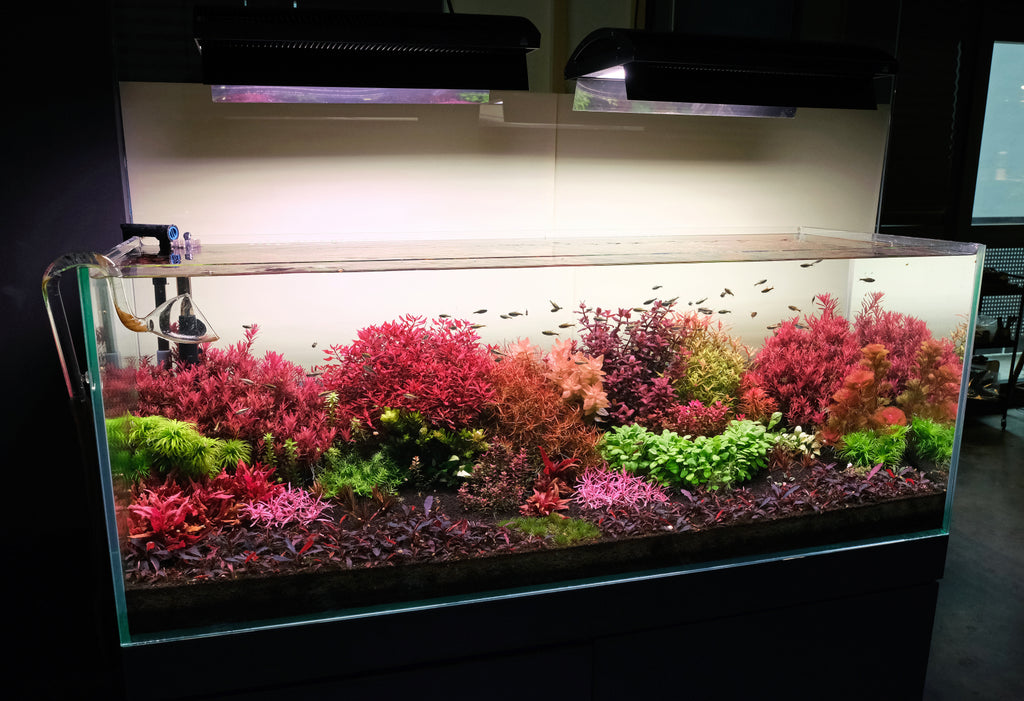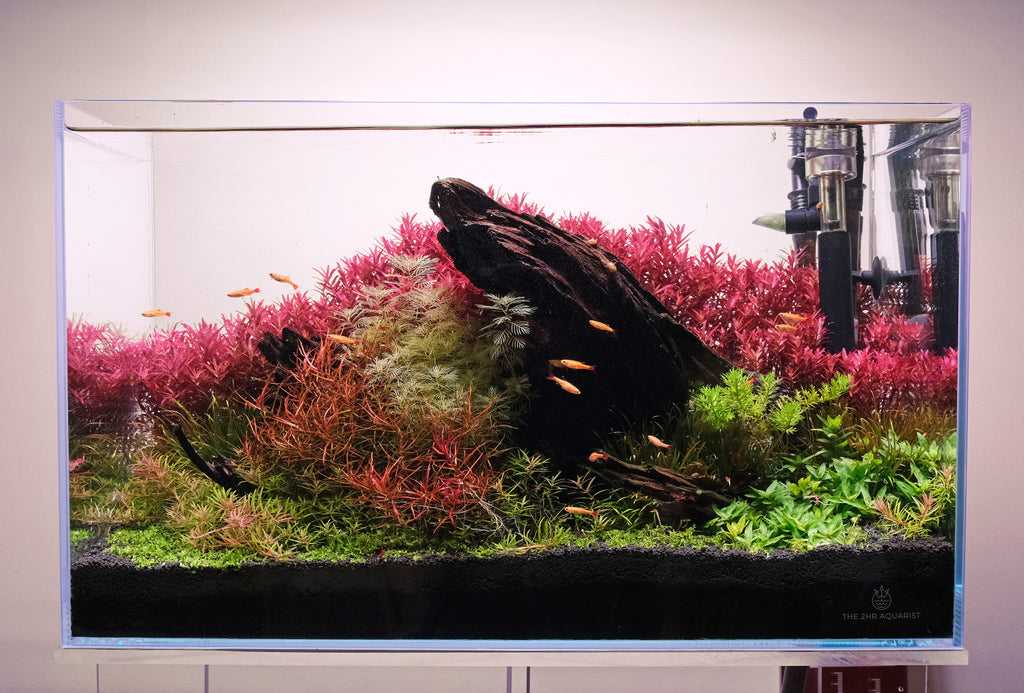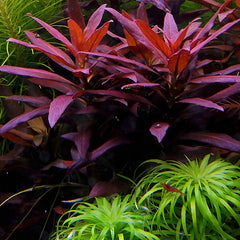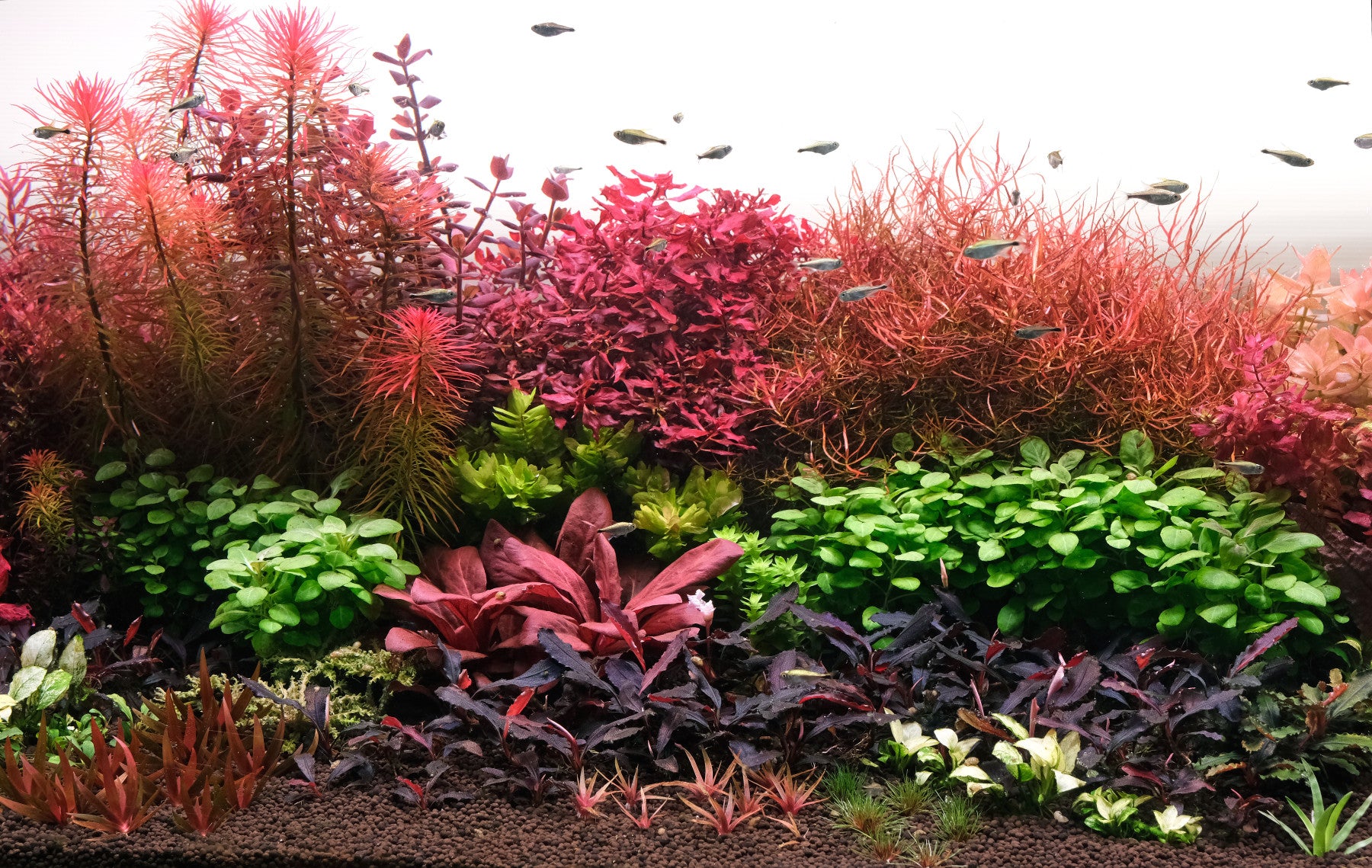Your Cart is Empty
How to grow red aquarium plants
February 05, 2025 14 min read

Red plant' is a generic term we use for non-green plants in this case. Many hobbyists make the mistake of thinking that a single variable alone is responsible for making colourful plants grow well. In almost all cases, it takes a combination of factors working well together to produce good results.
Many hobbyists fixate on iron, thinking that adding more iron alone will produce richer colours, but this is a myth. For example, we dose less than 0.05ppm of iron per day in our 2hr tanks (all plants above and most below). There are many other factors to consider.
How to get stronger reds and richer colors?
Different red plants respond to slightly different variables, but there are certain factors that will work across the board.
 Tank grown using APT Complete for water column dosing, and APT Jazz in substrate
Tank grown using APT Complete for water column dosing, and APT Jazz in substrate
Plants need to be healthy to show their best colours
Plants need a range of nutrients to be healthy and look their best; many people believe the myth that dosing more iron will automatically make red plants more red, but this is not the case. While iron is necessary for general plant health, and healthy plants will develop better pigmentation, dosing iron at higher levels than required will not result in stronger pigmentation. On the other hand, other elements, including phosphates and magnesium, are often under-dosed by aquarists because many commercial fertilisers are deficient in these components.
The basic rule for growing red plants well is that they must be healthy. Many aquarists overlook the basics - unhealthy plants are rarely aesthetically pleasing. This means understanding the requirements of a regular fertilisation regime, good CO2 control, water flow, substrate management and plant husbandry. A stable aquarium environment is also important as plants take time to grow into good form.

Ludwigia 'pantanal' is a fast growing stem plant that reacts quickly to changes in its environment. It is a live nutrient and CO2 test kit. We grow ours with a rich substrate but leaner water column. The above tank is dosed with APT Complete at standard dosage. Less than 0.05ppm Iron a day, and our NO3 levels in the water column measure <5ppm.
CO2 levels impact plant coloration greatly
Different plants require different levels of CO2. It is a common misconception that injecting CO2 only speeds up the rate of growth and has little effect on the health or shape of the plant. Injecting CO2 not only speeds up growth by 4-10 times, it also has a huge impact on the health and colouration of many plant species. Most coloured plant species require CO2 injection to show their best colour. Some species such as Ludwigia 'Pantanal' and Eriocaulon quinquangular require much higher levels than simpler plants such as Rotala rotundifolia and its variants.
A general level that works for most plant species is around 30ppm. Finicky species such as Eriocaulon quinquangular do better at 40ppm+.
This can be targeted by using the relative pH drop method described here.
 Even easy to grow species, such as Bacopa colorata (above, center), are sensitive to CO2 levels. Bacopa colorata loses its pink hues quickly within days of losing CO2 access.
Even easy to grow species, such as Bacopa colorata (above, center), are sensitive to CO2 levels. Bacopa colorata loses its pink hues quickly within days of losing CO2 access.

Rotala rotundifolia species can grow decently red without CO2 injection. However, CO2 injection is necessary to get higher density bushes as CO2 encourages branching of stem plants which gives the bushy look.
Stronger light (higher PAR values)
The more light you have over the tank, the more pigmentation you will get. The downside of pushing the light levels up is the increased chance of algae in the tank. If you have healthy plants and a clean tank, you can use higher light levels without having algae problems.
Around 100umol PAR on the substrate is firmly in the high light category where you would expect good density and colouration for most coloured plants. On average, most such plants can be grown in tanks with much lower PAR (70umols +), but the colouration and density will only be more impressive towards the top of the tank where the light is stronger. For many species there is an improvement in colouration when PAR is around 200umols compared to 100umols. Above 200umols (measured at substrate level) there are diminishing returns. There is also a high maintenance cost to keep these very highlight tanks free of algae.

AR mini (left) growing in a tank where substrate PAR is around 100+. However, if you want Proserpinaca palustris (right) to color up well, you will need much more light than that - even in high light tanks, it usually only gets much redder closer to the top of the tank/lights where PAR values are 300++.
 Species such as Ludwigia super red colour easily. This plant shows good colour even without CO2 injection.
Species such as Ludwigia super red colour easily. This plant shows good colour even without CO2 injection.

The substrate PAR in this tank is around 200+ umols. This is sufficient to colour virtually any coloured aquarium plant, but less experienced people may have problems keeping the tank free of algae.
For most aquariums where the aim is to grow coloured stem plants, starting with a PAR of 100 umols is a good level that is reasonably easy to manage.
Another factor that greatly affects light access is plant positioning. Placing a light demanding plant in the shade of a taller plant will be detrimental to the plant. The same applies to planting a delicate species between aggressive plants that will crowd it out.

Rotala florida is light demanding and will not tolerate being shaded by taller species. Planting in open areas with plenty of light is the key to its success.
Stronger red/blue spectrum
Having a strong red/blue spectrum in the lighting system has two effects. The first effect is visual; if you have stronger red light, red plants will be better illuminated. The second effect is that stronger red/blue lighting stimulates pigmentation in many plants, meaning that many red plants will both grow redder and look redder under a strong red spectrum. RGB LEDs have much better spectrum coverage and colour rendition than pure white LED units. T5 users can use a mix of coloured tubes to get a spectral profile that works for their tanks.
Modern LED units with narrow spectral peaks using red-green-blue diodes can produce very vivid hues and good saturation while maintaining a neutral white backlight. This is not possible with older T5 technology. In recent years, the majority of tanks in the 2hr lab have been grown using such RGB LEDs.
You can read more on choosing an effective LED here.
Below are examples of tanks run on LEDs with good coloration, yet with a neutral white backlight.


Good colour rendition in a tank is when you can see coloured plants in the tank in all their different shades, not just a uniform red. This is also the difference between a tank that has only red saturated lighting and a tank where individual species have been grown well enough to show their individual hues. If the aquasoil in a tank looks purple, the lighting is probably too purple to accurately show the hues of the plants.


The Bucephalandra brownie ghost in a tank with more blue lighting (left) versus more neutral lighting (right). Iridescent plants are particularly affected by the colour rendition of the lighting system. Make no mistake, red plants will definitely look redder if there is plenty of red light to reflect - but it is a balance to achieve a result that looks striking rather than fake.

The Week aqua a430 produces strong red visual tones with a white backcast. Rotala blood red SG is shown above, together with Ludwigia arcuata.
Nitrate limitation
Nitrate limitation means that less nitrogen is added to the tank compared to other nutrients. This lack of nitrogen delays the development of chlorophyll in certain plants, causing them to grow redder. This only works for some specific species (Rotala rotundifolia, Ludwigia arcuata/brevipes) and has no significant effect on others (Althernanthera reineckii, Ludwigia super red, Ludwigia senegalensis). Limiting nitrogen should be done carefully, as plants that prefer richer nutrient levels may stunt if levels drop too low. (e.g. Ludwigia pantanal).

Ludwigia sp. red is the same red in both low and high NO3 growth environments, it just grows in a smaller form when nutrient access is low. These two strains are grown from the same cutting but in different nutrient environments.
In order to limit nitrate effectively in an aquarium, planning should be done in advance. If you are going to be low in nitrates in the water column, it makes sense to use a rich substrate to compensate. Nitrate limitation seems to be influenced more by the water column dosage of NO3 than by the substrate. For species that require low nitrogen to be red, you would typically aim for 5ppm or less residual NO3 in the tank water column. Ammonia rich aquasoils are a perfect counterpart to this strategy as they provide a store of nutrients for plants to draw from, albeit by a slower mechanism than water column fertilisers. Feeding N through the root system seems to allow such plants to experience the effects of N limited increased colouration without stunting. Most plants actually adapt well to low water column doses as long as the substrate is rich. Every single aquatic species we've seen can be grown with rich substrate + lean water column dosing. However, richer water column dosing produces more robust forms in many species.
Plant selection/combination also plays a role. If you are planning to grow very red Rotala H'ra (or other variants of Rotala rotundifolia), which require very severe nitrogen limitation - with water column NO3 levels close to 0 for long periods (weeks) - then you should not attempt to grow plants that grow optimally at richer nutrient levels in the same tank.
Most of the plants that respond well to nitrate limitation (examples are listed below) also respond well to a stronger red/blue spectrum and stronger light. This means that you can choose a middle ground; where nitrates are low but not allowed to bottom out (say 5ppm), paired with stronger red/blue shifted light to get reasonably good colour from plants that need nitrate limitation to get red.

Rotala H'ra under light nitrate limitation on the left (5ppm NO3 in the water column, but under stronger lighting) vs. H'ra under heavy nitrate limitation (0ppm NO3 in the water column - plants are mainly root-fed by aquasoil). There is no way to get Rotala rotundifolia varieties this uniformly red without letting NO3 bottom out over a long period of time.
A side-by-side comparison of Rotala H'ra grown on two different nutrient regimes at similar PAR levels:

A side by side comparison picture of Ludwigia arcuata grown under two different nutrient regimes, under similar PAR light values:


Ludwigia arcuata (top right) becomes a flaming bush when grown in high light, low water column nitrates and ammonia rich substrate.
There are a few easy red plants that will easily turn red as long as their fertilisation needs are met and PAR levels are not too low (50umols +); these include Nymphaea zenkeri 'red', Ludwigia sp.red, Echinodorus 'rubin' and variants. The various coloured Cryptocorynes are also generally easy to grow: C. Undulata red (reddish/brown), C. flamingo (pink/only TC is difficult), C. 'Hobbit' (brown), + others. These are the easiest red plants to grow for beginners just starting out.
Many other plants also have guaranteed red undersides of leaves (even if their tops are greenish); Althernanthera reineckii species, Ludwigia repens/palustris. Rotala 'Blood red SG version' and Bacopa salzmannii 'SG version' are both easy to grow and have a brilliant colour, but it may be difficult to find stock of these two species as they are not widely propagated by commercial farms.
 Bacopa salzmannii 'SG version" on left and Rotala 'Blood red SG version' on right.
Bacopa salzmannii 'SG version" on left and Rotala 'Blood red SG version' on right.
There are a few plants that are more difficult in terms of requirements, but always give good colour if you can grow them. In order below: Ludwigia glandulosa (purple, not too hard), Rotala ramosior 'Florida', Rotala mini butterfly, Samolus parviflorus red.



 Most other red plants require at least high light levels and a decent spectrum (more red/blue) for stronger colouration. These are plants that generally start out red, but become much redder depending on how much the light spectrum is red/blue shifted, and often require much more light than the average tank to colour optimally. Examples: Rotala macrandra and its many varieties, Ludwigia senegalensis, Didiplis diandra, Persicalaria 'Sao paolo' (purple).
Most other red plants require at least high light levels and a decent spectrum (more red/blue) for stronger colouration. These are plants that generally start out red, but become much redder depending on how much the light spectrum is red/blue shifted, and often require much more light than the average tank to colour optimally. Examples: Rotala macrandra and its many varieties, Ludwigia senegalensis, Didiplis diandra, Persicalaria 'Sao paolo' (purple).


 Rotala macrandra mini type 4, Top and side view
Rotala macrandra mini type 4, Top and side view


Then there is the group of plants that show redder pigmentation due to nitrogen limitation/low nitrate growth conditions (which delays the development of chlorophyll). This category of plants will grow significantly redder when deprived of nitrogen: Rotala rotundifolia red and its many variants (Rotala colorata, H'ra, Yao yai, etc), Ludwigia arcuata, Ludwigia brevipes, Hygrophila araguaia, Hygrophila pinnatifida, Limnophila aromatica/hippuroides (topside). Many other plants that are partially red will also have larger red areas under limited NO3; Eriocaulon quinquangulare, Trithuria lanterna. However, most of these plants will also colour better under high PAR and a stronger red/blue spectrum. So a not too low NO3 level in the water column, coupled with good lighting, is something of a middle ground that is easy to achieve for many tanks.
Certain species such as Rotala rotundifolia variants and Ludwigia arcuata only get very red under nitrate limitation and will not achieve high levels of redness no matter how much light you throw at them without NO3 limitation. If you are planning to grow these species to a very high level of redness, it is better to design a tank where the dosing approach is lean as a whole.

Ludwigia arcuata (right) and Ludwigia pantanal (left); not ideal tank partners. Ludwigia arcuata becomes much redder at low NO3 levels, whereas Ludwigia pantanal stunts easily if conditions are too lean. One way we overcome this is by using a richer root fertiliser. This allows us to maintain a slightly leaner water column and still grow species that are more fertiliser hungry.
Planning ahead - choosing plants for a certain style of tank
THE LEAN DOSING TANK
In these tank systems the plants are mainly root fed - this is typical of ADA style systems where the water is very nutrient poor (especially nitrogen) but the soil is rich. Nitrate limitation occurs naturally over time if you follow the typical ADA dosing approach which is very low in water column NO3.
This approach is best suited to heavy hardscape tanks with sparse planting and large unplanted areas, or scapes where there is generally little nutrient uptake (where the majority of plants are slow growers such as Java fern, Anubias or Bucephalandra). This approach keeps the water column lean which means less incidence of dust algae on hardscape/glass, reduces dosing requirements (saving cost + time) and is suitable for plant combinations that produce good colour under lean conditions. Rotala rotundifolia (and its many variants) and ludwigia arcuata (below) are a staple in many ADA style layouts and they grow to good form with good colour with this approach. The same plants become super weedy in EI style high dosage tanks, but are more green/orange than red (and often leave hobbyists puzzled: "I'm dosing so much, why aren't my plants red?!"). Iwagumis also do well with this approach. Many plants will also grow in smaller forms under lean dosing; myriophyllums that grow huge under EI will stay more reasonable size in lean dosing tanks. This is useful for keeping plants under control and following aquascaping contours.
The main disadvantage of such a system is that it relies on rich soil to grow hungry plants. Even carpets will not grow well without a soil substrate in this scenario. If you are relying on the richness of the substrate to supply nutrients, then you will need to pay extra attention to the quality of the substrate. (and fewer hobbyists have experience in this area as it is a subject that is rarely discussed). What happens is that these ADA style tanks with Aquasoil often start out with strong growth, but this tails off over a year. By this time, many aquascapers have simply resorted to adding more soil. This is not to say that such an approach is not sustainable in the long term - substrates need to be enriched over time, compacted layers loosened and excess organic matter removed. Many aquascapers fail to manage substrate health because they think they can just leave it untouched forever, as this topic is almost never discussed (unlike water column dosing, which is a popular topic).
With a very low water column, hungry plants can temporarily stunt during replanting cycles as their root zone takes time to develop. This means that the aquarist should prune the tops off whenever possible and allow the lower parts of the stems to regrow, as replanting the tops takes time for the plant to re-establish the root system. Aquascaping styles that involve frequent replanting of the tops may not fare as well with this approach.

THE MIDDLE GROUND (slight NO3 limitation)
You do not always have to go for an extreme system. We like our 2hr tanks to be NO3 limited, but not to the extreme. We maintain low NO3 levels - enough to get good colour (but not super redness) from plants that need low NO3 to be red, but this middle ground also allows us to grow any plant species on the market to good form. We find that most coloured stem plants work well under this system - their growth rate is more controlled, allowing us to maintain the look of a tank with less frequent pruning. You can read more about the exact dosing levels we use on the dosing systems page. Whilst maintaining low NO3 levels in the water column, we balance this by using a rich substrate with frequent additions of Root Tabs. Plant growth is more controlled, which reduces the need for pruning.
The main difficulty with this approach is similar to the lean dosing approach above; it requires good soil substrate management. In terms of water column, what is lean for one tank may be too lean for another - this requires the aquarist to have some experience in interpreting plant growth forms; this can easily be learned over time by the observant, but is likely to be difficult for the novice. Maintaining a low but consistent macro level also requires strict discipline in dosing and monitoring plant health.

RICH WATER COLUMN DOSING APPROACH (EI style tanks)
This style is suitable for tanks with a heavy plant load that can take advantage of the rich water column levels. If you have a plant-dominated layout, the water column dosage will reach all the plants regardless of whether they have found a good spot on the substrate. Subsequently, this approach requires less attention to substrate richness and allows you to manage a planted tank without fussing with soil. Many plants will grow stronger, bigger and faster with a rich dosage. If you enjoy pruning plants to sell, this is an advantage. This approach gives the fastest growth and allows aquascapes to be completed more quickly when time is of the essence.
This approach is ideal for fast growing plants and aggressive growers will do better than in lean tanks. Delicate samples (due to transport, poor stock or attempts to propagate difficult species) also have a better chance of survival as they can access nutrients more easily.
This approach is also particularly suitable for aquascaping layouts where topping and replanting is frequent; the plant can take up nutrients through the water column before having to fully establish a new root zone. Joe Harvey's (burr740) tank below demonstrates a good water column dosing technique with an inert substrate.
The main drawback to this approach is the need for good water parameter management (more complex than it looks on paper) and regular dosing. We find that for sparsely planted layouts with low nutrient uptake, an extremely rich water column introduces instability - while nutrients themselves are rarely the trigger for algae blooms, when you do trigger algae blooms (and most hobbyists will at some point) they are more severe in tanks where the water column is heavily dosed compared to tanks with a leaner water column. If you are doing a simple Iwagumi or Hardscape heavy scape with sparse planting, we find the instability of heavy water column fertilisation to be a significant drawback.


Tom Barr's 120-Gal tank above.
Concluding remarks
Choose plants and a dosing method based on your aquascaping goals. If you think about it, the fish world accepts that hard water cichlids should never be kept with soft water killies. Is it so hard to accept that plants can thrive in different conditions? Although the rules are not as strict in the plant world (many tanks can grow most species) - our plants come from many different regions and habitats around the world. Designing tanks to grow species that grow well together in similar conditions will certainly go a long way to influencing results.
Click here to find out more about optimising CO2 and flow.
Click here to find out how to read PAR values.
Click here to section on detailed care guides to aquarium plants.
unlock your true potential
Grow anything, defeat algae, create amazing aquascapes

























